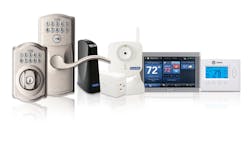When it comes to the value of innovation in manufacturing, Ingersoll-Rand PLC (IW 1000/307) is a company that “gets it.”
Dublin, Ireland-based Ingersoll-Rand, whose diverse product portfolio includes Club Car golf cars, Schlage locks and Trane HVAC systems, views growth through innovation as one of three core strategies for the company.
“The bottom line for Ingersoll-Rand is that we’re trying to create a premier-performing company, and we think there’s a direct relationship between that and a company that’s growing through innovation,” says Paul Camuti, CTO and senior vice president of innovation.
In its push to develop “a more innovation-centric mindset,” as the company explains in its 2011 annual report, Ingersoll-Rand created Camuti’s C-level post last year.
Camuti, who works in the company’s North American headquarters in Davidson, N.C., joined the company this past August with the mission of “fostering a culture that embraces innovation in all that we do.”
“We think that for the company -- for the benefit of our employees, our customers and our shareholders -- that people obviously want to work, invest and partner with companies that are growing and that are innovative,”
Camuti tells IndustryWeek.
Even before the company created a C-level post dedicated to innovation, Ingersoll-Rand had been building some momentum. In 2011, new products and services -- those that have been introduced within the last three years -- contributed 23% to the company’s $14.8 billion in total net revenue, up from 13% in 2008.
Camuti, who previously served in various senior-leadership positions at Siemens AG (IW 1000/34) for more than 16 years, says he’s no stranger to that metric, known as the “vitality index” within Ingersoll-Rand.
“When you first start focusing on it, you usually gain a lot of momentum, because you’re investing in new products and services, and you have a spurt of new things come to market, so the number usually goes up dramatically in the first couple of years,” Camuti explains. “But it becomes hard to sustain, because the things that were new three years ago fall out, so you need new stuff to replace the somewhat new stuff that’s in that three-year window.”
A big part of Camuti’s job is implementing a common innovation process that ensures a pipeline of enough “new stuff” to keep the vitality index consistently near 20%.
With four disparate business segments -- Climate Solutions, Industrial Technologies, Residential Solutions and Security Technologies -- that’s a challenging proposition. But it’s a top priority for CEO Michael Lamach, who, since taking over in February 2010, has emphasized the need to establish common processes and “really extract the synergies” from the company’s business units, Camuti says.
“Were there processes in the company for generating ideas, developing ideas, selecting ideas and implementing ideas? Yes, there definitely were,” Camuti explains. “In fact, we probably had every way that you could imagine for generating ideas -- outcome-driven innovation, voice of the customer, customer surveying, observation, ethnographic modeling -- but none at critical mass and none consistently across the business segments.”
After a year on the job, Camuti notes that Ingersoll-Rand has made “rapid progress” in developing a common portfolio-management system, built on standard processes such as stage-gate.
“We’ve already done our first iteration of reviews on these new processes,” he says. “They’re beyond development and in implementation.”
New Business Models
A common innovation framework will serve the company well as it continues to mine advancements in information and communication technology to launch new products and services and enhance existing ones -- an opportunity that cuts across all of Ingersoll-Rand’s business units, Camuti says.
“There’s not a business that we have where information and communication technology isn’t changing either the performance of our products and services that we’re currently thinking of or radically changing the business model under which we operate,” he says.
The company recently launched Trane Intelligent Services, through which Trane offers around-the-clock remote monitoring of commercial HVAC systems based on customer-specified performance parameters. On the residential side, Ingersoll-Rand last year introduced its Nexia home intelligence system, which enables homeowners to remotely manage door locks, heating and cooling, video surveillance, lights, shades and energy usage via web-enabled computers or smartphones.
The technology even has infiltrated the golf course, where GPS systems in Club Car golf cars enable users to calculate yardage or order sandwiches before they hit the turn.
As for what the intersection of IT and Ingersoll-Rand products might look like in the future, the company in June announced that it completed the first phase of a pilot program that tested a high-tech student-spending application at the University of San Francisco.
Students participating in the pilot downloaded Ingersoll-Rand’s aptiQmobile web-based credentialing app onto their personal iPhones, enabling the students to use their phones -- instead of their campus IDs -- to enter residence halls and pay at laundry terminals.
The app, which integrates with the university’s campus-card system from CBORD Group Inc., leverages near-field-communication technology -- and provides another example of how “the pace of innovation around information and communication technology is just getting faster and faster,” Camuti says.
“Whenever I bring it up, I’m almost apologetic about it, because people have been talking about information and communication technology for a long time,” Camuti says. “But the point I like to make is that we’ve all agreed that the growth of information and communication technology is an exponential curve, and the longer you hang around an exponential curve, the more exciting it gets.”
About the Author
Josh Cable
Former Senior Editor
Former Senior Editor Josh Cable covered innovation issues -- including trends and best practices in R&D, process improvement and product development. He also reported on the best practices of the most successful companies and executives in the world of transportation manufacturing, which encompasses the aerospace, automotive, rail and shipbuilding sectors.
Josh also led the IndustryWeek Manufacturing Hall of Fame, IW’s annual tribute to the most influential executives and thought leaders in U.S. manufacturing history.
Before joining IndustryWeek, Josh was the editor-in-chief of Penton Media’s Government Product News and Government Procurement. He also was an award-winning beat reporter for several small newspapers in Northeast Ohio.
Josh received his BFA in creative writing from Bowling Green University, and continued his professional development through course-work at Ohio University and Cuyahoga Community College.
A lifelong resident of the Buckeye State, Josh currently lives in the Tremont neighborhood of Cleveland. When the weather cooperates, you’ll find him riding his bike to work, exercising his green thumb in the backyard or playing ultimate Frisbee.

